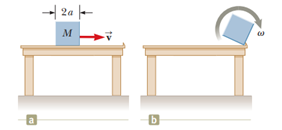Sliding Block

Problem Statement
A solid cube of side
Note: The cube undergoes an inelastic collision at the edge.
Key Concepts
- Frictionless Motion: The cube slides without friction, conserving momentum and energy until the collision [1].
- Inelastic Collision: The collision at the edge is inelastic, meaning kinetic energy is not conserved, but momentum is [2].
- Tipping Condition: The cube will tip over if the rotational kinetic energy gained from the collision is sufficient to lift its center of mass over the edge [3].
Approach
- Conservation of Angular Momentum: Use the conservation of angular momentum about the edge of the table to relate the initial velocity
to the angular velocity after the collision [4]. - Rotational Kinetic Energy: Calculate the rotational kinetic energy required to lift the cube's center of mass over the edge [5].
- Minimum Velocity: Set the rotational kinetic energy equal to the potential energy change and solve for
[6].
Solution
-
Angular Momentum Conservation:
-
Rotational Kinetic Energy:
-
Potential Energy Change:
-
Tipping Condition:
Final Answer
The minimum value of
Footnotes
Frictionless motion ensures conservation of momentum and energy until the collision. ↩︎
Inelastic collisions conserve momentum but not kinetic energy. ↩︎
The tipping condition is derived by equating rotational kinetic energy to potential energy change. ↩︎
Angular momentum conservation relates initial velocity
to angular velocity . ↩︎ Rotational kinetic energy is calculated using the moment of inertia
and angular velocity . ↩︎ The minimum velocity is determined by setting rotational kinetic energy equal to potential energy change. ↩︎